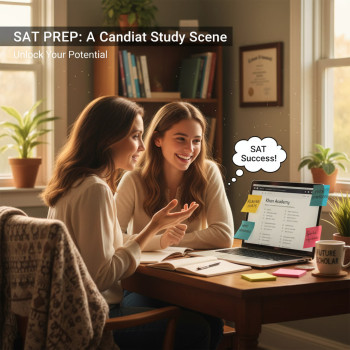Where You Are Right Now: Breathe — the SAT Is One Step, Not the Whole Journey
First: congratulations. Whether you just finished the Digital SAT, finished earlier this year, or are waiting to see scores, you’ve completed a major milestone. For many students and families, the SAT feels like the gatekeeper to college. The reality is kinder: it’s one important piece of a much larger puzzle. After the SAT, the practical steps are simple, but the strategy matters.
This guide walks you — the student and the parent — through the smartest next moves after the SAT. I’ll explain how colleges use scores, what to do with your results, how to send scores, and how to fold SAT performance into a strong application. I’ll also show how tailored support — like Sparkl’s personalized tutoring with 1-on-1 guidance, expert tutors, and AI-driven insights — can fit naturally into the plan when you want focused improvement or a calmer, clearer process.
Step 1 — Understand Your Score (and What It Really Means)
When scores come back, the first impulse is often to celebrate or panic. Instead, take three calm actions:
- Look at the overall score and section-level performance. The Digital SAT reports a composite score plus subscores; notice which question types or sections were strongest or weakest.
- Compare your score to the ranges posted by the colleges you’re interested in. Schools typically publish admitted-student score ranges (middle 50%). That tells you whether your score makes you a likely admit, a match, or a reach.
- Think about context: coursework rigor, GPA trends, extracurricular accomplishments, recommendation letters, and essays matter a lot — sometimes more than one test score.
If your score is lower than hoped, that’s okay. You can retake the SAT; you can also strengthen other parts of your application. If you’re within or above your target range, you can focus energy on essays, supplements, and applying strategically.

Step 2 — Decide Whether to Keep, Send, or Retake
Colleges have various policies — test-optional, test-blind, test-flexible, and test-required — and those policies can change. Here’s how to make the decision that fits your situation:
When to send your current score
- If your score is at or above a school’s middle 50% range, sending it can strengthen your application and potentially qualify you for merit aid.
- If you’re applying to competitive programs that often consider scores for scholarships or honors (engineering, finance, some STEM programs), consider sending even if your score is slightly below the middle range — but be strategic.
When to retake the SAT
- If your score is meaningfully below your target and you can reasonably improve with a focused study plan, plan for a retake. Often targeted practice (focusing on specific question types) yields the best gains.
- If you’re close to a cutoff for scholarships or program entry, a small bump can make a difference.
- If you want to strengthen college options or feel your test day didn’t reflect your true ability (illness, distraction), a retake is reasonable.
Score-sending strategies to consider
- Superscoring: Many colleges combine your highest section scores from multiple test dates — check each college’s policy.
- Score choice: You can usually choose which scores to send, but some schools require all scores from all test dates; verify before deciding.
- Timing: Send scores in time for application deadlines. For Early Action/Early Decision, make sure the scores you want considered are reported before the deadline.
Step 3 — Build and Balance Your College List
After the SAT, refine your college list. A healthy list has reach, match, and safety schools. Remember, the “best” college is the one where you’ll learn, grow, and be supported.
Practical factors to weigh
- Fit: majors, class sizes, campus culture, location.
- Outcomes: graduation rates, career placement, internship pipelines.
- Cost: sticker price vs. net price after scholarships and aid.
- Admission policies: test-optional vs. test-required, application deadlines.
Tools you should use
- College planning sites that let you compare admitted-student score ranges and net-price calculators.
- Student Search Service — opt in if you want colleges and scholarship programs to find you based on your profile and SAT scores.
- School-specific pages to confirm whether they superscore, require all test dates, or are test optional.
Step 4 — Translate Your Score into Application Strategy
Your SAT score informs a few concrete application decisions:
- Where to apply early decision or early action — use higher scores to bolster early apps where competition is stiff.
- Which schools might offer merit scholarships — many use SATs as part of scholarship formulas.
- Whether to focus effort on additional materials that showcase strengths that scores don’t capture, like portfolios, research, or a compelling personal statement.
What to do if your score is lower than your GPA suggests
Use context — your essays and counselor recommendations can explain growth, course rigor, or test-day anomalies. Some schools weigh GPA and coursework more heavily than a test score.
Step 5 — Complete the Application Components (Beyond Test Scores)
Applications are a mosaic. The SAT is a bright tile, but the rest — essays, recommendations, activities, transcript — complete the picture. Here’s a simple checklist and timeline:
| Task | When to Start | Why It Matters |
|---|---|---|
| Create a college list and research requirements | Summer before senior year / Early senior year | Ensures you know essay prompts, portfolio needs, and deadlines |
| Write and revise personal statement | Early senior year (or late junior year) | Essays show voice, resilience, and fit — they differentiate you |
| Request teacher recommendations | At least one month before deadlines | Teachers need time to reflect and write meaningful letters |
| Gather resume of activities | Summer / Fall | Helps write essays and complete application activity sections |
| Submit applications | Check each college’s deadline (Early: often Nov; Regular: often Jan) | Missing deadlines can close doors; start early |
Writing essays that matter
Admissions officers read thousands of essays. The standout ones are honest, specific, and reflective. They don’t need to be dramatic — they need to be true to you. Draft early, get feedback from teachers or a mentor, and polish.

Step 6 — Send Scores Correctly and Track Them
When sending SAT scores to colleges, be methodical.
- Confirm each college’s score policy: do they superscore? do they require all test dates?
- Schedule official score reports so they arrive before application deadlines.
- Keep a checklist tracking which colleges received scores, application status, and any follow-up items.
Small administrative mistakes — like missing a required score report — are common but avoidable. A spreadsheet and deadlines reminders go a long way.
Step 7 — Financial Aid: Use Scores to Your Advantage (When Possible)
SAT scores can influence merit scholarships. Many colleges award automatic scholarships based on test scores and GPA. To maximize aid:
- Check each college’s scholarship criteria early — some run on rolling deadlines or require score thresholds.
- Complete the FAFSA and any institutional aid forms (CSS Profile) as soon as possible after October 1 for best consideration.
- Apply for outside scholarships; use Student Search and scholarship-match tools to find relevant opportunities.
Simple aid checklist
- FAFSA: Complete every year you’re in college.
- CSS Profile: Required by some private colleges.
- Merit scholarship applications: Note separate deadlines and required materials.
Step 8 — Manage Communications, Interviews, and Demonstrated Interest
After you submit, stay proactive. Some colleges track demonstrated interest (email opens, campus visits, interview scheduling). Thoughtful but measured engagement can help show fit.
- Respond professionally to college emails and invitation requests.
- Prepare for optional interviews: practice common questions and have a few thoughtful questions to ask.
- If you visit campuses, document your impressions — you’ll use them in essays or decision-making later.
Step 9 — Make the Final Decision (and Don’t Panic over the Wait)
Acceptance, waitlist, and denial are all part of the process. When offers arrive, compare financial packages side-by-side — don’t just compare sticker prices. Think about academic fit, campus life, support services, and long-term outcomes.
| Consideration | Questions to Ask |
|---|---|
| Cost | What is the net price after scholarships and aid? Are there renewable merit awards? |
| Academic Fit | Does the college have strong programs and internships in your area of interest? |
| Support | Are there mentoring, tutoring, career services, and mental health resources? |
| Outcomes | What are graduation and employment rates for graduates in your intended major? |
Practical examples: Two different student paths
Example A: Maya — the upward-trajectory student
Maya’s first SAT returned a score slightly below her GPA’s implication. She retook the SAT after four weeks of focused, targeted practice on timing and data analysis problems. Her second test rose by 70 points, which moved her from match to reach for one of her dream schools and unlocked a merit scholarship at another. She paired that score improvement with an essay about how she balanced AP workload with community volunteering — a narrative of growth the admissions committee appreciated.
Example B: Jamal — the balanced applicant
Jamal’s SAT score was solid but not outstanding for his target schools. He chose to focus on exceptional internships and a portfolio project in digital design. He sent his SAT score to schools that request it and relied on his portfolio and recommendation letters to highlight fit for design programs. The result: three acceptances with attractive financial aid from schools that valued demonstrated talent and preparation more than a top SAT number.
How Personalized Support Can Help — When and Why to Consider It
Not everyone needs extra help, but targeted support can be transformative for many students. Personalized tutoring offers:
- 1-on-1 guidance to address specific weaknesses (e.g., math problem types or reading strategies).
- Tailored study plans that fit busy schedules and prioritize high-impact practice.
- Expert tutors who offer feedback on essays, college lists, and application strategy.
- AI-driven insights to track progress and adapt practice to where you’ll gain the most.
For families considering tutoring, look for programs that combine expert human coaching with data-driven practice. If you want a calm, individualized approach that includes both score improvement and application coaching, consider exploring personalized tutoring options like Sparkl’s — especially when time is limited and targeted improvement matters.
Final Checklist: The Two-Week Pre-Deadline Sprint
- Confirm all essay prompts are final and proofread by at least one trusted reviewer.
- Verify teacher recommendations have been submitted.
- Make sure official transcripts and test score reports are ordered.
- Double-check each college’s application portal to confirm materials received.
- Submit FAFSA and any institutional aid forms early.
Parting Advice for Parents and Students
Support matters. Your role as a parent is to be steady and practical: help manage deadlines, proofread essays when asked, and—most importantly—listen. Students, remember that colleges want curious, resilient people who will contribute to their communities. A single test score doesn’t define you.
Whether you’re improving scores, polishing essays, or deciding among offers, a calm plan wins. Use checklists, keep clear communication with recommenders, and don’t be afraid to ask for help. If targeted tutoring — focused practice, expert essay feedback, and personalized strategy — would reduce stress or sharpen results, that support can be a smart investment.
Closing: You’ve Got This
The road after the SAT has many routes: retake, send, apply, or pivot. Each choice is reasonable when made with clear information and a thoughtful plan. Take it one step at a time, celebrate each milestone, and remember that college is about learning and becoming — not just a number. If you want a tailored plan to improve scores or a helping hand through applications, leaning on experienced, individualized tutoring can both reduce stress and improve outcomes.
Good luck. The next chapter is waiting — and it’s shaped by the whole of who you are, not just one test.















No Comments
Leave a comment Cancel